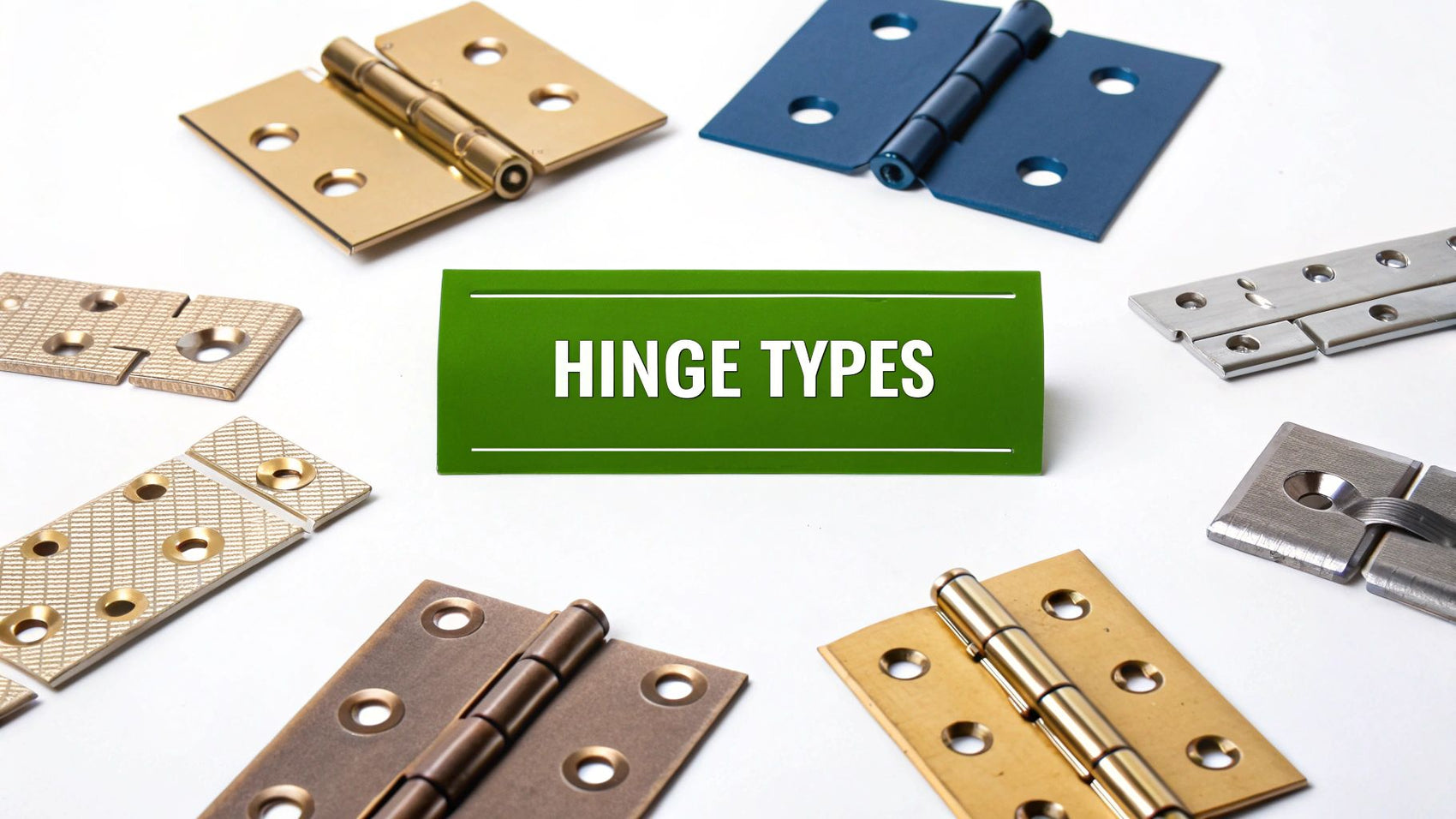From rustic gate hinges to the clever, invisible mechanisms in modern kitchens, the world of hinges is surprisingly vast. You've got everything from traditional butt hinges for doors and decorative strap hinges for gates, to the concealed hinges that give cabinets that seamless, modern finish.
Picking the right one isn't just a minor detail—it's absolutely crucial for how your project looks and performs for years to come.
A Practical Guide to Choosing the Right Hinge
Think of a hinge as the unsung hero of any moving part. It’s the silent workhorse that lets a heavy oak door swing effortlessly or a kitchen cabinet close with a satisfyingly soft click. Get this choice right, and everything works beautifully. Get it wrong, and you're setting yourself up for sagging doors, misaligned cabinets, and frustrating squeaks down the line.
This guide is here to walk you through the options, cutting through the jargon. We'll look at everything from the weight a hinge can handle to the material it's made from, helping you pick the perfect hardware with complete confidence. Given the UK's lock and hinge manufacturing market is valued at £1.0 billion, it's clear how vital these components are to construction and renovation projects across the country.
Choosing a hinge isn't just about function; it's a design choice. The right hinge enhances the style of your door or furniture, while the wrong one can feel jarring and out of place.
Whether you’re a professional joiner or a weekend DIY warrior, getting the fundamentals right is what matters most. Understanding the basics will ensure your project not only looks great but also stands the test of time.
To help you get started, we've put together a quick overview of the most common hinge types you'll encounter.
Quick Overview of Common Hinge Types
This table breaks down some of the most popular hinge styles, their ideal uses, and what makes them unique. It's a great starting point for finding what you need.
| Hinge Type | Primary Use | Key Feature |
|---|---|---|
| Butt Hinge | Internal and external doors | The classic, versatile choice for most standard doors. |
| Concealed Hinge | Modern kitchen cabinets | Completely hidden when the door is closed for a clean look. |
| Strap Hinge | Gates, barn doors, sheds | Long leaves provide extra support for heavy, wide doors. |
| Pivot Hinge | High-traffic or large doors | Rotates on a single point at the top and bottom of the door. |
| Continuous Hinge | Lids, industrial doors | Runs the full length of the door for even weight distribution. |
| Self-Closing Hinge | Cabinet doors, fire doors | A spring mechanism automatically pulls the door shut. |
| Speciality Hinge | Custom furniture, unique builds | Designed for specific, non-standard applications. |
Each of these types serves a distinct purpose. By matching the hinge to the job, you ensure your doors, gates, and cabinets will function flawlessly for years to come.
1. The Classics: Butt and Continuous Hinges
When you think of a hinge, the image that probably comes to mind is the classic butt hinge. It's the unsung hero of the hardware world, found on countless doors in homes and businesses all over the UK. The design is brilliantly simple: two matching plates, known as leaves, are connected by a central pin to form a strong, reliable pivot.
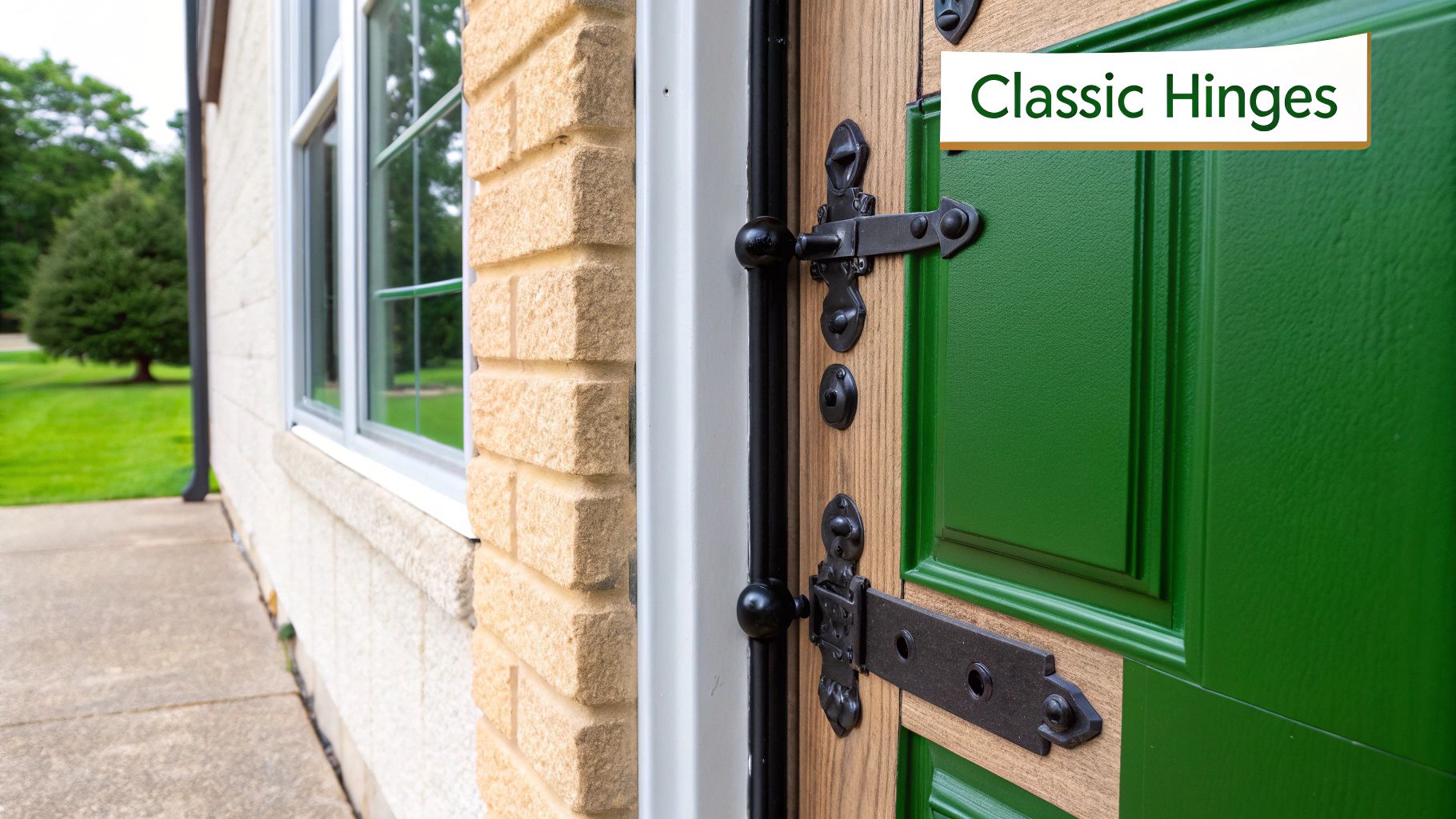
To get that clean, professional look, butt hinges are usually mortised. This just means a small recess is carved into the edge of the door and the frame, allowing the hinge to sit perfectly flush. The result is a tidy finish with a tight, even gap all around the door. It's this straightforward design and reliable function that makes them the default choice for most standard jobs.
Variations on a Classic Theme
Of course, not all butt hinges are made the same. Different situations call for slightly different designs. For instance, if you're hanging a heavy solid-core or fire-rated door, you'll want to use ball-bearing hinges. These have tiny, hardened steel bearings tucked between the hinge's knuckles. They drastically reduce friction, making even the heaviest doors feel light and swing smoothly without a sound. For a really substantial door, something like a Grade 13 Ball Bearing Hinge is a must for ensuring it performs well for years to come.
Another smart variation is the rising butt hinge. It’s a clever piece of engineering that gently lifts the door by a few millimetres as it opens. This is the perfect fix for rooms with thick carpets or uneven floors, preventing the door from dragging and getting damaged.
The Unfailing Support of Continuous Hinges
Now, let’s switch gears. Imagine a hinge that isn't just a few inches long, but runs the entire height of the door. That's a continuous hinge, although you’ll often hear it called a 'piano hinge' because that’s where it first made its name—on the lids of pianos.
The real genius of a continuous hinge is how it spreads the door's weight evenly from top to bottom. This completely gets rid of the stress points you'd find on standard hinges, making it practically impossible for the door to sag or drop over time.
This incredibly robust design makes them perfect for high-stress or heavy-duty situations. Think industrial doors, secure cabinets, fold-down workbenches, or even the lid on a large toy box. They provide unwavering support where it’s needed most. As a bonus, their gap-free design also enhances security and provides a better seal against draughts.
For a Modern, Minimalist Look: Concealed and Pivot Hinges
If you're aiming for that clean, contemporary finish, you'll want hinges that practically disappear. This is where the concealed hinge comes into its own. You might know it as a European hinge – it's the go-to for modern kitchen cabinets and sleek, fitted wardrobes, and for very good reason.
When the door is closed, the hinge is completely hidden from view. This creates that seamless, hardware-free look that really lets the design of the cabinetry shine.
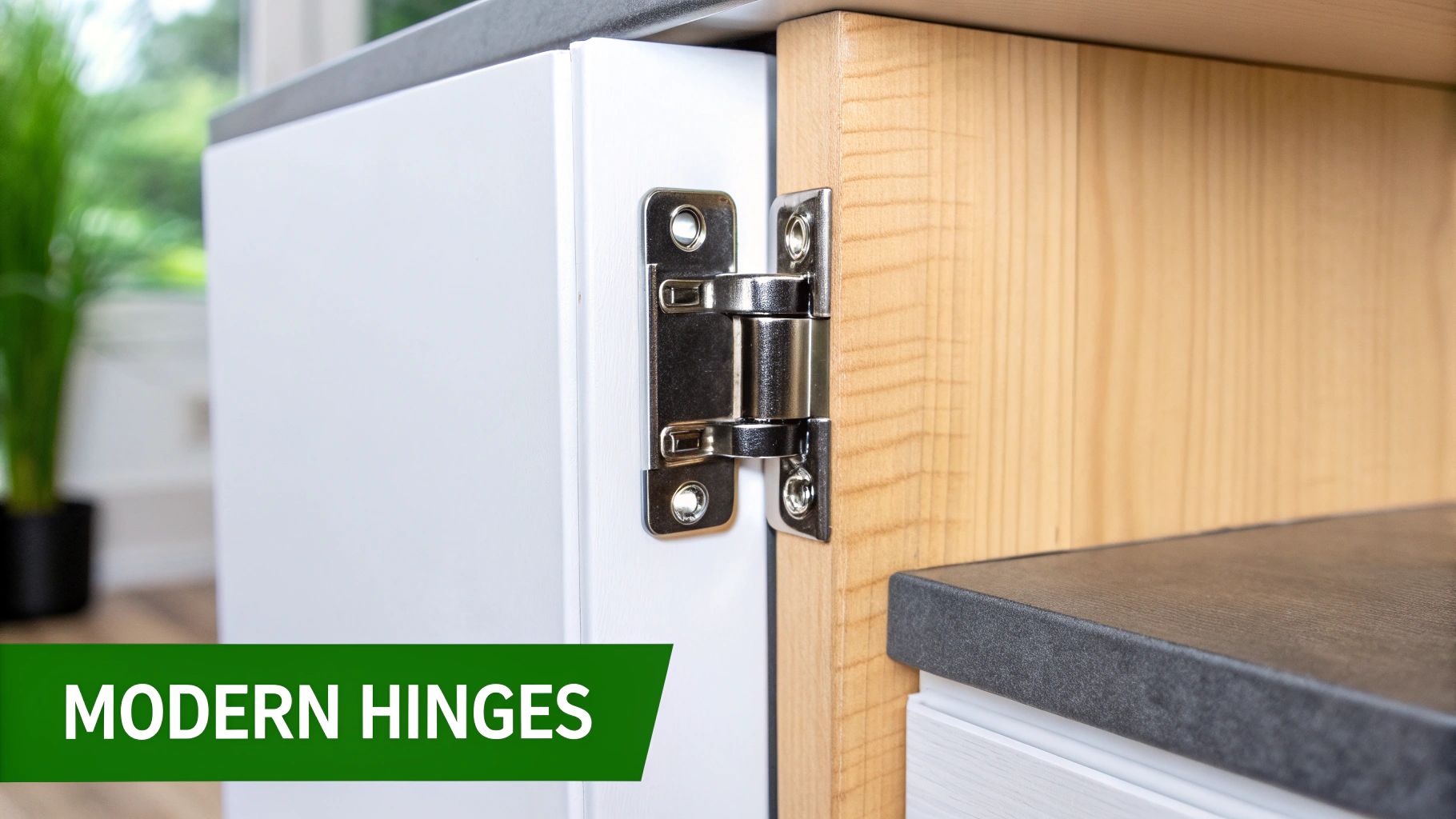
But their real genius is in the adjustment. Unlike old-school hinges, these offer three-way adjustment (up/down, left/right, and in/out). This makes getting perfectly aligned doors with consistent gaps an absolute breeze, which is a massive plus for professional fitters and weekend DIYers alike.
The Architectural Drama of Pivot Hinges
Another brilliant option for a minimalist aesthetic is the pivot hinge. Instead of fixing to the side of a door and frame, pivot hinges are installed right at the top and bottom. This allows the door to swing from a single point, creating a dramatic, almost floating effect that feels incredibly modern and sophisticated.
A pivot door makes for a truly striking entrance. Because the pivot point can be set in from the frame, they are also a fantastic solution for creating unusually wide openings. If you're curious about the mechanics, understanding pivot door mechanisms gives a great insight into how they work.
The real trick is that the door's weight is borne by the floor, not the frame. This makes pivot hinges the perfect choice for those oversized, exceptionally heavy statement doors made from solid wood, glass, or even metal.
This unique way of carrying the load makes them unbelievably robust. In fact, innovative designs like these are a big reason why the global hinge market is now valued at over £4.5 billion. Their ability to handle serious weight while maintaining such a subtle profile has made them a firm favourite with architects and interior designers chasing that high-end, architectural finish.
Decorative and Heavy-Duty Strap and Tee Hinges
Not all hinges are meant to be hidden. Some, like strap and tee hinges, are designed to be a prominent feature, mixing raw strength with a bit of visual flair. They’re the hinges you turn to when you need both serious support and a touch of rustic, traditional style.
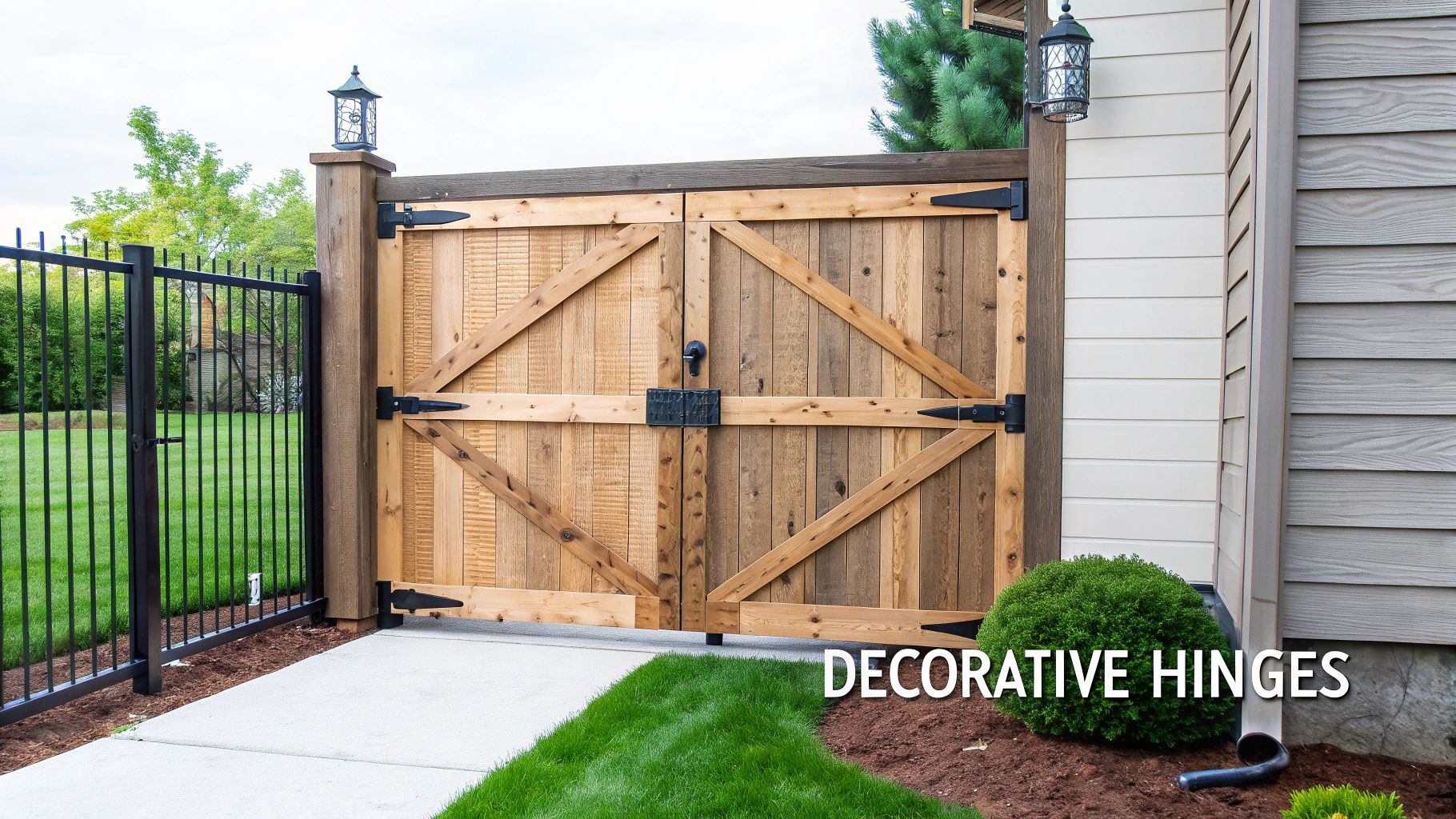
You can spot a strap hinge from a mile away. It has two long, typically triangular leaves that stretch right across the face of a door or gate. This isn’t just for looks—that extra length is a masterstroke of engineering. It spreads the load of a heavy door across a much wider surface area, which is brilliant for preventing sagging and keeping everything hanging true.
The Power of Strap Hinges
Their sheer brawn makes them the only real choice for big, heavy-duty jobs where a standard butt hinge just wouldn't stand a chance.
- Barn Doors: They have the muscle needed to handle those wide, solid timber barn doors without breaking a sweat.
- Large Gates: The long leaves provide fantastic leverage and support for chunky garden or driveway gates.
- Garage Doors: Old-school, side-hung garage doors often rely on strap hinges for their rugged durability.
Beyond their practical muscle, the bold, visible design of a strap hinge becomes a key part of the aesthetic, lending an authentic, handcrafted feel to the whole project.
The Versatile Tee Hinge
Now, the tee hinge is a smart hybrid. It borrows the rectangular mounting plate from a butt hinge and marries it with the long, tapered arm of a strap hinge. This creates that distinctive 'T' shape and gives you the best of both worlds: a solid fix to the door frame and that crucial extra support across the door's surface.
This clever design has cemented the tee hinge's place as a classic for outdoor joinery. It offers a lot more strength than a simple butt hinge but without the full-on visual impact of a large strap hinge. It's the perfect middle ground for medium-duty tasks.
You’ll see them everywhere on garden gates, shed doors, and even old wooden chests. Their visible design adds a bit of classic hardware charm while providing the reliable strength needed for years of outdoor use. For that timeless look, you can't go wrong with classic black garden gate tee hinges that tick both the style and performance boxes.
Specialised Hinges for Unique Applications
Sometimes, the standard options just don’t cut it. When you’re dealing with a unique design or a tricky installation, you need to look beyond the everyday butt or concealed hinges. This is where the world of specialised hinges opens up, offering clever solutions for everything from custom furniture to high-end joinery.
Think about the quiet elegance of modern kitchens. That satisfyingly gentle thump as a cupboard door closes is often down to a soft-closing hinge. These have become incredibly popular for a reason—they use a tiny built-in damper that catches the door in the final few centimetres of its travel, preventing slamming. It’s a small detail that not only feels luxurious but also helps protect your cabinets from wear and tear over time.
Advanced and Invisible Solutions
For the true minimalist, nothing beats the clean look achieved with barrel hinges. These are small, cylindrical mechanisms that are drilled right into the edge of the door and the frame. When the door is shut, they are completely invisible. This makes them perfect for smaller, delicate projects like jewellery boxes or small display cabinets where any visible hardware would spoil the design.
Cabinet makers also rely heavily on overlay and flush hinges to get the perfect finish. The choice between them dictates exactly how the cabinet door sits in relation to the frame. An overlay hinge lets the door sit slightly proud of the cabinet face, creating a classic look. A flush hinge, on the other hand, allows the door to sit perfectly level with the frame for a seamless, modern appearance.
This infographic breaks down how these specialised hinges compare in terms of their key benefits and how visible they are once installed.
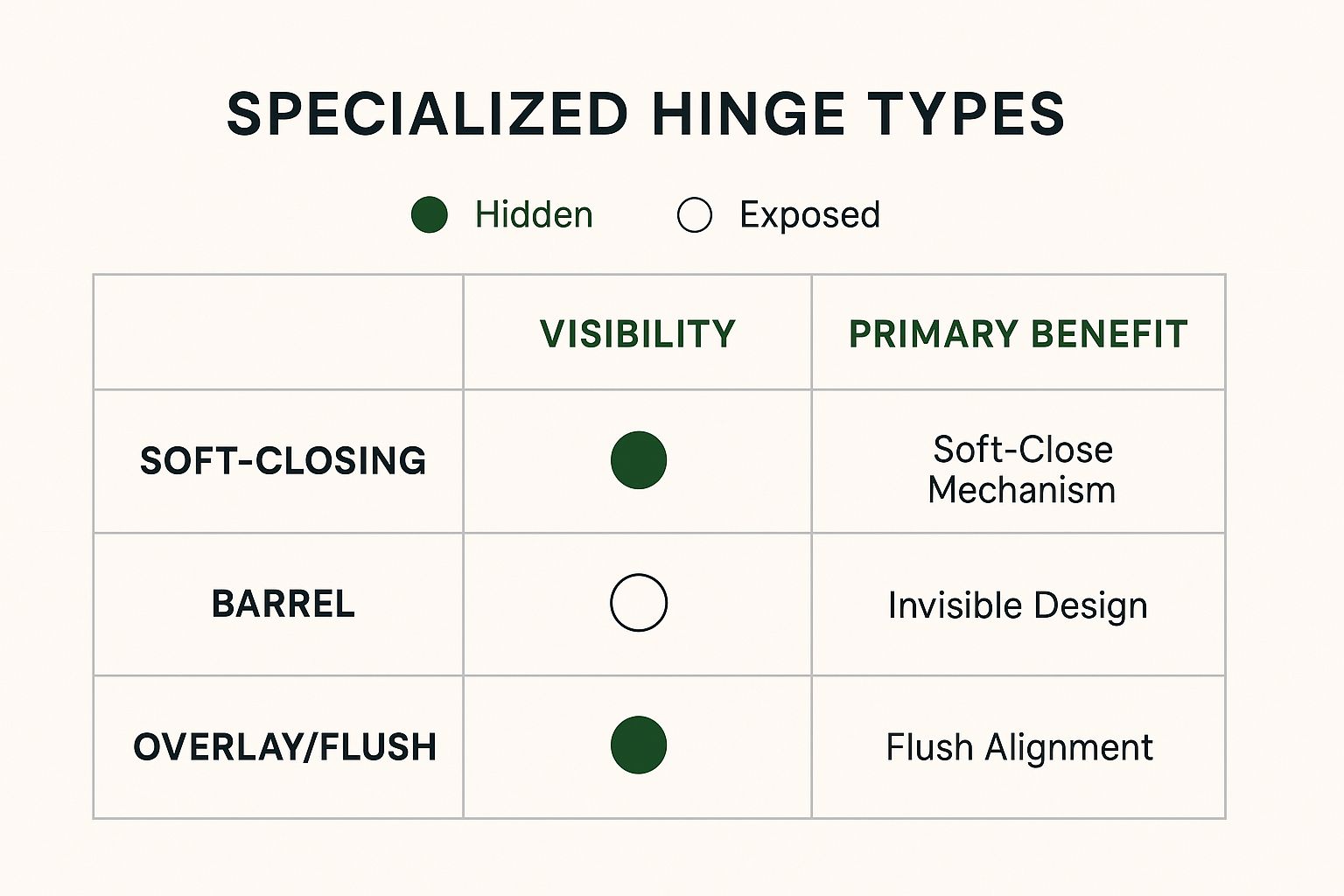
As you can see, there’s often a trade-off between function and aesthetics. While soft-close and barrel hinges are designed to be hidden, others like overlay and flush hinges are chosen for the precise visual effect they create.
This kind of innovation is a huge part of why the global door hinges market was recently valued at £7.9 billion. As construction and design evolve, so does the demand for smarter hardware. You can learn more about the door hinges market growth on gminsights.com. For heavy-duty applications, such as those in a garage, exploring specialised garage door accessories can reveal even more options.
Hinge Feature Comparison
To help you choose the right specialised hinge for your project, this table compares their main features at a glance.
| Hinge Type | Best For | Key Advantage | Consideration |
|---|---|---|---|
| Soft-Closing | Kitchen and bathroom cabinets | Prevents slamming, reduces noise and wear | Can be bulkier and more expensive than standard hinges. |
| Barrel | Small boxes, display cases, lightweight doors | Completely invisible when the door is closed | Requires precise drilling for installation. |
| Overlay | Face-frame cabinetry, traditional furniture | Creates a classic, defined look for cabinet doors | The door sits proud of the frame, which may not suit all styles. |
| Flush | Inset doors, modern, seamless designs | Allows the door to sit perfectly level with the frame | Requires a very precise fit to look right. |
Choosing the right hinge often comes down to balancing the look you want with the functionality you need. Whether it's the hidden strength of a barrel hinge or the quiet convenience of a soft-close mechanism, there's a specialised solution for nearly any design challenge.
A Few Common Questions About Hinges
Choosing the right hinge can feel surprisingly complicated, but it doesn't have to be. Over the years, we've heard just about every question there is. Here are a few of the most common ones we get, with some straightforward, practical advice.
How Many Hinges Does My Door Actually Need?
For a standard internal door here in the UK (usually around 2040mm tall), you should always fit three hinges to prevent warping. It’s tempting to just use two, but that third hinge in the middle provides crucial support, stopping the door from bowing or twisting over time. It’s a simple step that makes a huge difference to how the door hangs long-term.
Of course, for smaller, lighter doors under 1524mm, two hinges will often do the job just fine. But if you're dealing with a heavy solid wood door, a fire door, or one with glass panels, you absolutely need at least three. For particularly hefty doors, a fourth hinge isn't out of the question. Your best bet is always to check what the manufacturer recommends for both the door and the hinges themselves.
What's the Real Difference Between a Mortise and a Non-Mortise Hinge?
This all comes down to how they're installed. A mortise hinge is the traditional choice for doors, where you carve out a shallow recess (the 'mortise') in both the door edge and the frame. This lets the hinge leaves sit perfectly flush, creating a very tight, strong fit with a clean, professional look.
A non-mortise hinge, as the name suggests, skips the carving. You just screw it directly onto the surface of the door and frame. They're designed so one leaf fits neatly inside the other. While they are a lot quicker to install, they always leave a bigger gap between the door and the frame. They're really best for lighter-duty jobs, like small cabinet doors or decorative boxes, not your main entryways.
Think of a mortise as creating a seamless, interlocking connection. It’s like fitting puzzle pieces together for a stronger, more integrated result that looks far more polished.
Can I Just Paint My Hinges to Match?
Technically, yes, but it's an idea that sounds much better than it works in practice. We generally advise against it, especially for any door you use regularly. The simple act of opening and closing will quickly cause the paint around the hinge knuckles to crack, peel, and flake off.
Not only does this look messy, but those little flakes of paint can actually get into the mechanism and make the hinge stiff or squeaky. It’s always better to buy hinges in the finish you want from the start—whether that's satin nickel, polished brass, or matt black. If you're absolutely set on painting them, use a good metal primer and apply the thinnest coats you possibly can to avoid gumming up the works.
How Do I Pick the Right Size Butt Hinge?
There's a simple rule of thumb here: the hinge needs to be wide enough to let the door swing open fully without catching on the architrave or door trim. For most standard internal UK doors, which are about 35-44mm thick, a 76mm (3-inch) butt hinge is the go-to size.
When you move to bigger, heavier external doors, you'll need to step up to 102mm (4-inch) hinges to give you the strength and stability required to handle the extra weight.
At Burnt Oak Builders Merchants, we've got a huge variety of hinges for pretty much any job you can think of, from robust gate hardware to clever concealed cabinet hinges. Take a look at our full range online to find the perfect fit for your next project.
Find the Right Hinges for Your Project at Burnt Oak Builders Merchants

